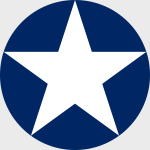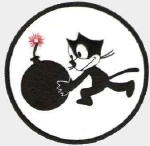Hobby Master HA8902 USN Grumman F4F-4 Wildcat Fighter - Lt. Commander John Thach, "White 23", VF-3, USS Yorktown (CV-5), June 4th-6th, 1942 (1:48 Scale)
"Skipper, it really worked. I couldn't make any attack without seeing the nose of one of your airplanes pointed at me."
- Ensign Edward "Butch" O'Hare discussing the newly-developed "Thach Weave" maneuver with Lt. Commander John Thach
 The Grumman F4F Wildcat was the standard carrier-based fighter of the United States Navy for the first year and a half of World War II. An improved version built by General Motors (the General Motors FM Wildcat) remained in service throughout the war, on escort carriers where newer, larger and heavier fighters could not be used.
The Grumman F4F Wildcat was the standard carrier-based fighter of the United States Navy for the first year and a half of World War II. An improved version built by General Motors (the General Motors FM Wildcat) remained in service throughout the war, on escort carriers where newer, larger and heavier fighters could not be used.
The Wildcat was outperformed by the Mitsubishi Zero, its major opponent in the Pacific war, but held its own by absorbing far more damage and wielding more firepower. With heavy armor and self-sealing fuel tanks, the Grumman airframe could survive far more than its lightweight, unarmored Japanese rival.
The original Grumman F4F-1 design was a biplane, which when proving inferior to rival designs was recast as the monoplane F4F-2. This was still not competitive with the Brewster F2A Buffalo which won initial US Navy orders, but when the F4F was fitted with a more powerful engine, the Pratt & Whitney Twin Wasp, it showed its true merits and became the F4F-3. US Navy orders followed as did some (with Wright Cyclone engines) from France; these ended up with the Royal Navy's Fleet Air Arm after the fall of France. In British service initially these were known as the Martlet I, but not all Martlets would be to the exact same specifications as US Navy aircraft. The F4F-3A would enter service as the Martlet III(B), the FM-1 as the Martlet V, and the FM-2 as the Martlet VI. The name Wildcat was still commonly used for these aircraft in spite of the official name change.
A new version, the F4F-4, entered service in 1942 with six guns and folding wings, allowing more to be crammed on a carrier; this was the definitive version and the one that saw the most combat service in the early war years including the Battle of Midway.
Grumman production ceased in early 1943 to make way for the newer F6F Hellcat, but General Motors continued producing them for both US Navy and Fleet Air Arm use, as larger fighters such as the Hellcat and the Vought F4U Corsair were too large for use on escort carriers. At first they produced the identical FM-1 model but then switched to the improved FM-2 (based on Grumman's F4F-8 prototype) with a more powerful engine and a taller tail to cope with the torque. In all, 7,251 Wildcats were built.
All versions of the Wildcat used hand-cranked landing gear with a relatively narrow track, making landing accidents where the landing gear were not fully locked into place distressingly common.
Pictured here is a 1:48 scale US Navy Grumman F4F-4 Wildcat fighter was piloted by Lt. Commander John Thach, who was attached to VF-3, then embarked upon the USS Yorktown (CV-5) at the Battle of Midway, from June 4th-6th 1942.
Sold Out!
Dimensions:
Wingspan: 9-1/2-inches
Length: 7-1/4-inches
Release Date: February 2019
 Historical Account: "The Thach Weave" - The Thach Weave (also known as a Beam Defense Position) is an aerial combat tactic developed by naval aviator John S. Thach and named by James H. Flatley of the United States Navy soon after the United States' entry into World War II.
Historical Account: "The Thach Weave" - The Thach Weave (also known as a Beam Defense Position) is an aerial combat tactic developed by naval aviator John S. Thach and named by James H. Flatley of the United States Navy soon after the United States' entry into World War II.
It is a tactical formation maneuver in which two or more allied planes would weave in regularly intersecting flight paths to lure an enemy into focusing on one plane, while the targeted pilot's wingman would come into position to attack the pursuer.
Thach had heard, from a report published in the September 22nd, 1941m Fleet Air Tactical Unit Intelligence Bulletin, of the Japanese Mitsubishi Zero's extraordinary maneuverability and climb rate. Before even experiencing it for himself, he began to devise tactics meant to give the slower-turning American Grumman F4F Wildcat fighters a chance in combat. While based in San Diego, he would spend every evening thinking of different tactics that could overcome the Zero's maneuverability, and would then test them in flight the following day.
Working at night with matchsticks on the table, he eventually came up with what he called "Beam Defense Position", but which soon became known as the "Thach Weave". It was executed either by two fighter aircraft side-by-side or by two pairs of fighters flying together. When an enemy aircraft chose one fighter as his target (the "bait" fighter; his wingman being the "hook"), the two wingmen turned in towards each other. After crossing paths, and once their separation was great enough, they would then repeat the exercise, again turning in towards each other, bringing the enemy plane into the hook's sights. A correctly executed Thach Weave (assuming the bait was taken and followed) left little chance of escape to even the most maneuverable opponent.
Thach called on Ensign Edward "Butch" O'Hare, who led the second section in Thach's division, to test the idea. Thach took off with three other Wildcats in the role of defenders, O'Hare meanwhile led four Wildcats in the role of attackers. The defending aircraft had their throttles wired (to restrict their performance), while the attacking aircraft had their engine power unrestricted - this simulated an attack by superior fighter aircraft.
Trying a series of mock attacks, O'Hare found that in every instance Thach's fighters, despite their power handicap, had either ruined his attack or actually maneuvered into position to shoot back. After landing, O'Hare excitedly congratulated Thach: "Skipper, it really worked. I couldn't make any attack without seeing the nose of one of your airplanes pointed at me."





 F4F-4 Fighter
F4F-4 Fighter 


